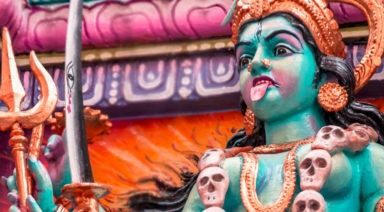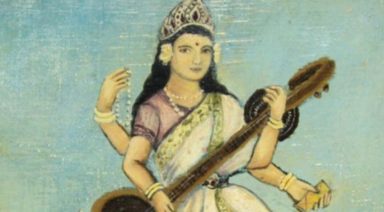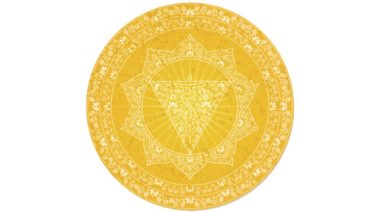How Lakshmi Teaches Us Discipline, Gratitude, and Abundance
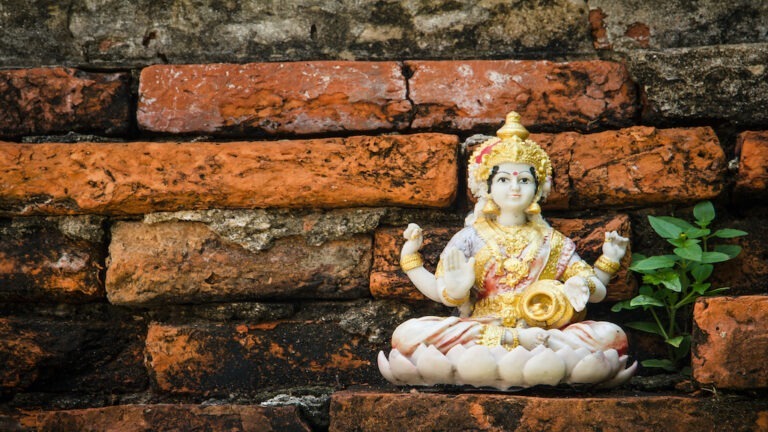
A long time ago, a dear friend of mine called me up, excited and ecstatic. She was engaged! But instead of immediately being happy for her, my mind went to my own life. How I was single and not even close to being married. A lifestyle I thought I should have been living by that point in my life. I was blinded by my own narcissistic tendencies and unable to feel true happiness for this woman who has, over the years, done nothing but generous, sweet gestures for me.
Fast forward to over a decade. I did yoga, and I chanted. But I also discovered that chanting to Lakshmi was helpful in invoking certain energies I wanted to embody. She is the goddess of adornment and beauty. She also asks us to use discipline to stay IN the practice. To feel abundance by focusing on what we HAVE versus what we are missing. She also allows us to feel true happiness and gratitude for people. She dissuades us from focusing on what we don’t have and instead on what we do.
I chanted and sang to her, Om Shreem Maha Lakshmiyey, calling upon the great goddess. As I chanted the mantra, which loosely translates to ‘my salutations and adoration to the great Lakshmi,’ I looked at my life and my choices. I was finally able to feel grateful for my individual path and appreciate the abundance of my life.
Lakshmi and Discipline
One day, Lakshmi woke up and felt the need for some time alone and space away from her duties. She decided to take a dive down into the deep milky ocean waters to take a long nap and a much-needed break.
Many years later, some demons started attacking the Universe. Demons often represent our negative thought processes and debilitating narratives. The demons were starting to win the battle. The gods spoke with Vishnu, Lakshmi’s husband, beseeching him to find her to help defeat the demons.
Vishnu, The Sustainer of the Universe and member of the Holy Trinity, acquiesced. He knew what ocean Lakshmi was in but not her exact location, so he found a stick and started churning the waters, hoping to rouse her from her self-retreat.
He churned for years and years, all the while the demons kept destroying everything he knew as righteous. But he was motivated and disciplined, continuing to churn. A little over a thousand years later, Lakshmi was convinced Vishnu really meant his call for her. She poked her head out of the surface of the water to ask him what was up. He filled her in, and long story short, she helped save the day.
This story shows us that Lakshmi showed up once she was convinced Vishnu meant his call by demonstrating his drive and motivation. But he had to prove he was disciplined enough and serious enough by churning the ocean for over a thousand years. This is what Lakshmi asks of us.
If we are ever in need of feeling gratitude or abundance and are calling on her, we must first show we are serious; serious about our request, our practice, and dedicated for the long haul. That’s when she shows up for us and helps us.
Lakshmi and Gratitude
The goddess is often seen sitting or standing on or near a lotus flower. The blossomed lotus, hovering above the surface of the water, represents purity. The lotus also represents the wealth contained in each moment of our experiences. But it’s a type of wealth unblemished by grasping or clinging.
We can learn to be grateful for so many things along the path of our journey, but Lakshmi asks us to loosen our grip on our expectations. And in this way, we start to experience true gratitude for all things and joyous for all moments big and small.
Lakshmi also asks that we make our lives beautiful, loving, and striving for balance and harmony. She is the goddess of adornment and Lakshmi is very much about giving. But it’s the type of giving that is done without any need for recognition.
Adorn yourself beautifully because you want to, not because you crave compliments. Help a friend in need without desiring recognition. It’s in these ways we will attract gratitude and the essence of Lakshmi. Gratitude will then be given and received in unexpected ways.
Like I mentioned earlier, chanting to Lakshmi, or using a Lakshmi mantra, will help us feel grateful for what we have. It will also help us feel grateful for people in our lives and happy for them regardless of our own circumstances.
OM SHREEM MAHA LAKSHMIYEY NAMAHA
Lakshmi and Abundance
We turn our attention inwards, looking to our body and our heart, which exist in the present moment and never lie. Upon closer observation, we then notice we hold the essence of Lakshmi inside of us. She is our divine inner spark, she is our inherent grace, and she is the abundance of limitless possibilities available to us. She helps us see our lives as enough, versus lacking in any way. This is how we feel abundance.
Lakshmi is often seen with coins spilling out of her hand. At first glance, the coins seem to portray material wealth, but they represent more than that. They represent worldly and spiritual prosperity.
The coins remind us that first, we must start with ourselves. Consider who we are and what we have in order to honor the abundance of our lives. We take a realistic evaluation of how we can truly take ownership of our lives. We become empowered by tapping into a feeling of deep inner abundance and true prosperity. We start to understand that abundance is not some external thing we emulate. It is truly a state of mind, and of remembering our own true nature beyond all the stuff.
As we learn to tap into the energy of Lakshmi and use her to motivate our practice, feel gratitude for our lives, and appreciate what we do have, we start to see things slowly begin to shift. Gratitude and abundance have no room for negative relationships, anger, fear, insecurities, or dishonesty. It’s then we begin to move from darkness to light.
Creating the Container for Kali: How the Goddess Shows Up in Your Life
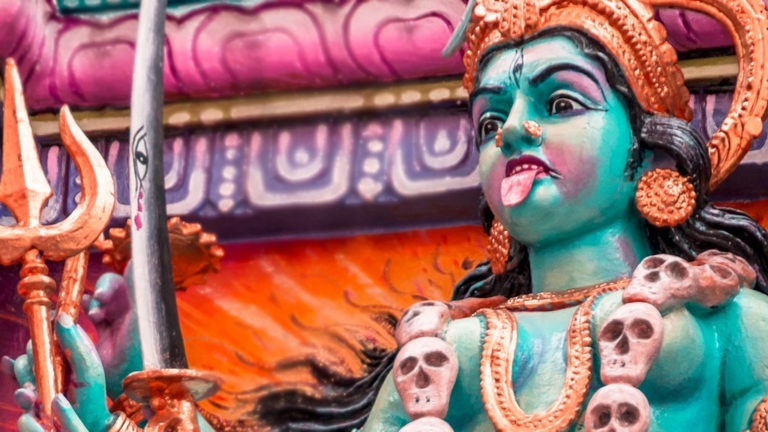
When I found her, Kali was waiting in the window of the Ma Shrine (a temple for female deities) at my new ashram home. I was mesmerized. She didn’t look anything like the other goddesses in the temple which was filled with examples of the feminine divine. All the other goddesses were wooden or metal, seated on a lotus or astride a peaceful looking mount. Even Durga carrying all her weapons and emanating powerful assurances sat calmly atop her tamed tiger.
In contrast, Kali was a smaller wooden statue painted in the brightest colors of the room. With jet black skin and the reddest tongue extended through her open mouth, reaching for me as if to swallow me whole, she wore a necklace of severed heads and a skirt of severed limbs.
She stood atop a resigned Shiva Lord of the Universe as a conqueror claims their prize. There was nothing peaceful about her! She was ferocious, and everything about her image should have been terrifying in my context of non-understanding. But I wasn’t afraid. I was drawn to her.
Kali was the first goddess I would ever have a relatable experience with from energetic understandings that lay beyond the perception of her form. I sat there and looked to her for what seemed like hours. Every day I would go to the Ma Shrine after our morning meditations and visit all the mother goddesses, offering Kali a flower and trying to feel what she was awakening in me: my power.
Years later, I became a mother myself. The day I became a mom, was the most beautiful experience of celebrating life and specifically that of my son, who is my everything. He is a constant source of inspiration for me still, just six and a half years along my journey into becoming a mother goddess. Love like this has no description you can place from pen to paper.



